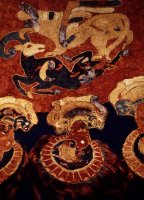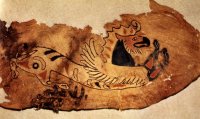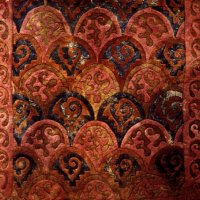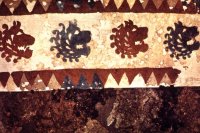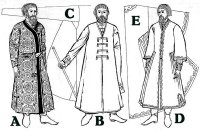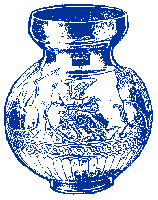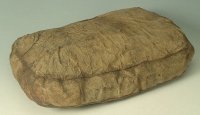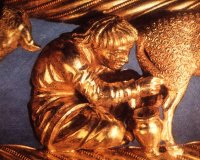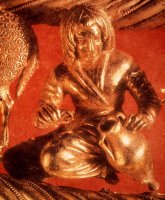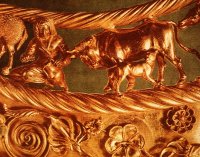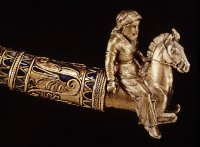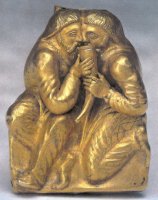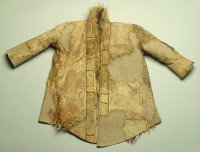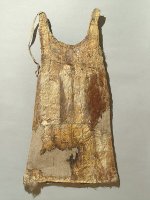 |
Textile information |
Any examples of actual textile-related grave goods (plus relatively close modern patterns which could be imitated) will go here. Also included are speculations on what certain grave goods possibly signified.
Appliques
Saddleblanket (?) of felt on leather, with dyed horse-hair tufts on the rondels
Former clothing? Looks like it was once hemmed, by the small symmetrical holes along the curved bottom edge. Is this actually Scythian? The hind legs aren't twisted about by 180 degrees, which is a characteristic of Sarmatian zoomorphic art, but it does share a lot of similarities with the above gryphon.
Carpet or wall hanging
A 15' x 23' wall hanging with 6 identical panels in multicolored felt with applique decorations was found in one grave. Two examples of the work in it represented here. The above is just a two-layer repeating pattern, but damn if it isn't eye-catchingly beautiful and complex looking. The one below is another very nice simple repeating pattern, although it's not as complicated a pattern as the first.
Clothing
Women
Common for elaborately buried females: decorated robes; a large, square hat. Apparently the tall hats are extremely important for priestesses and wealthy women, as they're very common in those burials:
- a large, tall, ornately decorated headdress of black colt's fur
- a tall hat with veiling hanging from it (?)
- the remains are described as "sumptuous & tall" or as a "witch's hat"
- a three-foot-tall conical hat of molded felt stretched over a light wooden frame, with wooden foil-covered images of 8 felines & birds on a tree
There are three types of footwear in burials of important/wealthy women:
soft, high leather boots with gold plaques covering the leg area
the footwear was gone, but there were hundreds of tiny pyrite beads which we guess were sewn on the soles -- must be indoor wear
an example taken from some amulets: wide-spaced lacings around the upper foot and up the front -- like mukluks?
Found in one grave: a fur apron with leather appliques
Men
Common for males: leather pants, boots. Seen on the wall hanging: a male (king/leader?) also wearing a caftan/kaftan (sp?). Kaftans are often lined with squirrel fur, and decorated with brightly colored felt appliques in floral designs. From what I can tell, the farthest left example of kaftan below (example A) is the closest in pattern to what the guy in the carpet wore.
A mid-thigh length version would seem close to what the Sarmatians routinely wore, at least according to the artwork, sculpture, and few actual examples I've seen.
General
Belts identify clan affiliation and rank; lots of metal plaques and metal ends and buckles
leather pouches (amulets? Contained hair & fingernail clippings)
Hay-stuffed leather pillow (18" x 13" x 4") from the 3rd to 4th century, currently in the State Hermitage Museum
Clothing graphics
The only depictions I know of which show Sarmatian women (!). They're milking sheep, I think, and one of them seems to have either a plethora of thin braids or dreadlocks, held back with some sort of headband. Is there a pattern inscribed on the face? Everyday clothing seems pretty identical to that of men.
End-cap on a torque; is this actually Scythian? Also, the strap over the foot looks like a proto-stirrup, but I'm guessing it's really one of the leather straps that binds the short boot on. If a stirrup were that snug around the foot, and you fell off, you couldn't get your feet out and you'd be dragged.
A gold plaque of Scythians, which was apparently originally sewn onto clothing. The guess is they're swearing blood brotherhood; their coats and pants seem to replicate what we've seen of Sarmatian clothing. Why does the one on the left have a pointed head? Is he wearing a cap of some sort?
Sarmatian child's fur coat (about 1' 2" long -- did I read that correctly?) from the 3rd to 4th century, currently in the State Hermitage Museum
Sarmatian hat (about 8" long) from the 3rd to 4th century, currently in the State Hermitage Museum. How is this thing worn? The long leather or silk wrappers or ties seem to cover the face?!
Fur and leather apron found in a Sarmatian grave (about 2' long) from the 3rd to 4th century, currently in the State Hermitage Museum. I'm not sure about the length measurement -- would a 2' apron be enough to protect one's clothing? Was it for a child, perhaps? Or, being of fur and leather, was it more to add another temporary layer of insulation?
Copyright © 1992-2025 B. "Collie" Collier. All rights reserved.
Web site design & maintenance: Laughing Collie Productions
Contact the web administrator for any technical problems
